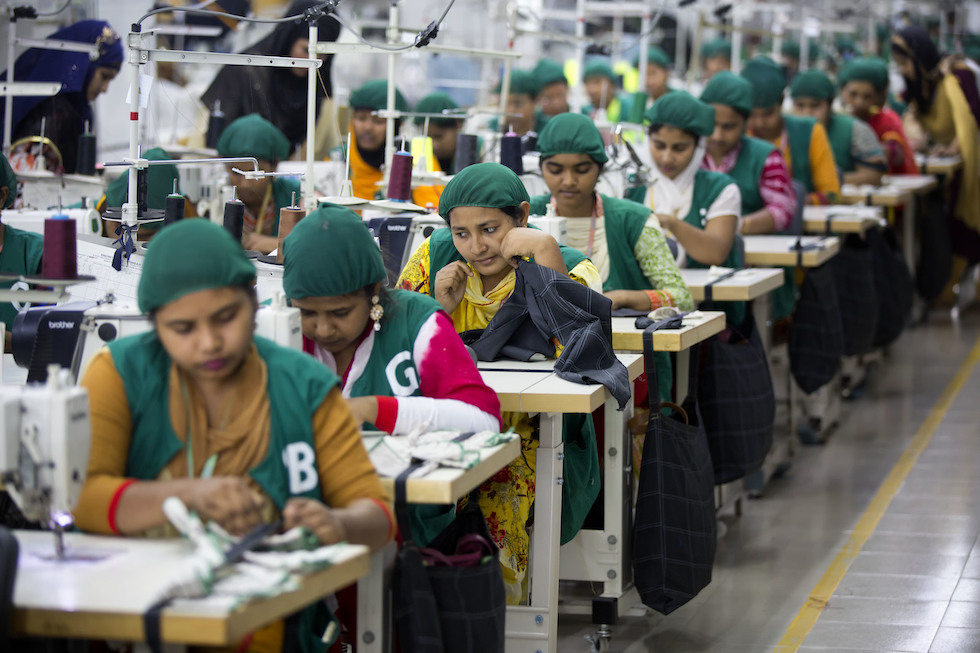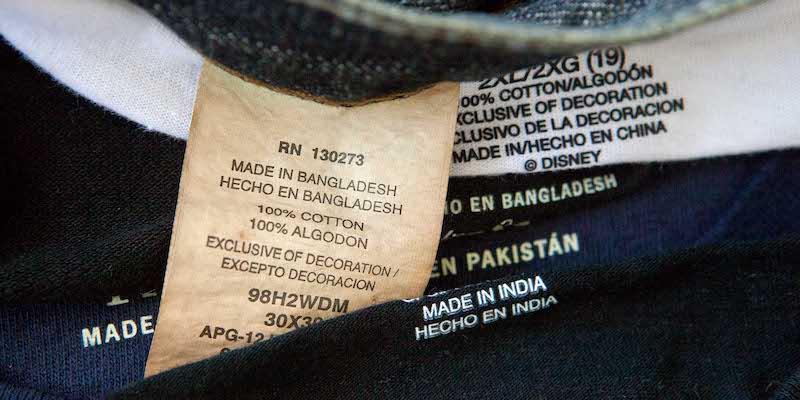On April 24, 2013 near Dhaka, the capital of Bangladesh, a nine-story building collapsed in which many textile manufacturing workers were working: the building was called Rana Plaza and due to the collapse they died 1.132 people. It was a catastrophic event, which prompted about 200 foreign (especially Western) clothing companies that produced their garments in Bangladesh to declare their willingness to commit themselves to improving the conditions of their employees, making them safer and more respectful of their rights.
Ten years later, things haven’t changed much: despite some small improvements in building safety, working conditions remain very bad, with very low wages, exhausting shifts and little transparency on the part of foreign companies on the composition of their production chain.
The Rana Plaza was located in Savar, about twenty kilometers northwest of the capital Dhaka. It collapsed shortly before nine in the morning: in addition to the dead there were more than 2,500 wounded. Just five months earlier, also near Dhaka, over 100 people had died in a major fire in another textile workshop.
The rubble of Rana Plaza, about ten days after the collapse (AP Photo/Wong Maye-E, File)
Survivors later recounted that factory managers had forced employees to go to work despite reports of deep cracks in the walls. During the investigation it also became known that one of the engineers involved in the construction of the building had declared just the day before the collapse that the building was not safe.

A relative of a person died at Rana Plaza protest on fifth anniversary of collapse (AP Photo/A.M. Ahad)
To produce their garments and maximize their profits, fast fashion companies – those that produce the cheapest and most widely distributed garments, such as H&M, Inditex (the Zara group) or Primark – they rely often to factories in countries where labor is very cheap. Such as Bangladesh, Pakistan and other countries in South Asia, but also in Africa or Latin America. In turn, factories often subcontract work, even without the knowledge of the companies that had commissioned them, to more easily manage their workloads.
It was known that the conditions of many of these laboratories were very bad and not subject to adequate controls even before the collapse of Rana Plaza, also due to other accidents, collapses and fires that occurred in the previous months and years. But the importance of that event and the visibility it had prompted many companies to equip themselves with tools to prevent others from occurring, most likely also for image and reputation issues. Around 200 companies – among which H&M, Inditex, Primark, Camaïeu, Prenatal, OVS, Mango and United Colors of Benetton, but also supermarket chains such as Lidl and Aldi – signed a historic agreement to improve safety conditions in Bangladesh’s laboratory buildings.
The agreement, signed on May 15, 2013, just over two weeks after the Rana Plaza collapse, foresaw a series of conditions, including binding agreements between companies and local unions of workers in the textile industry, the funding of independent inspections inside the factories, transparency on the results of these inspections, which had to be made public, an economic commitment to finance the restructuring interventions necessary to keep the laboratories in good condition and the right of male and female workers to refuse to work in conditions deemed unsafe. This second chord is known as International Accordinternational agreement.
The terms of the agreement were then progressively refined over the years, also following new incidents. In 2017, for example, a boiler explosion provoked the death of at least 10 people in a Dhaka factory: four years later, the boilers were added to the list of devices to be checked during inspections. A few years after the deal was extended to other countries with conditions similar to Bangladesh, such as Pakistan.
– Read also: China versus H&M
The agreements formulated after the collapse of the Rana Plaza allowed a general improvement of the conditions of many factories in Bangladesh: fire extinguishers and other fire extinguishing systems were added, electrical systems were renewed, building foundations were strengthened, occupational safety training programs were put in place. But it is still an incomplete process and in many ways insufficient: second data collected from BloombergAbout half of Bangladesh’s 4,500 garment factories have actually achieved the improvements under the agreement.
Furthermore, many companies decided not to sign the agreements, probably also to avoid the costs that entail: a Bloomberg one of the executives of PVH, the company that owns brands such as Tommy Hilfiger and Calvin Klein, said that for Pakistan’s factories alone, the safety deal costs nearly $200,000 a year and that the biggest companies , like his, must also cover the cost of hiring and training the engineers and experts involved in checking that the agreement is respected.
Of the major US companies, only three signed the Bangladesh factory safety agreement: American Eagle Outfitters, Fruit of the Loom, and PVH. Abercrombie & Fitch also agreed to sign it, but it is still not on the official list. The same three companies then also signed the international agreement.
Some companies then decided to regulate themselves autonomously, implementing procedures for verifying the safety conditions that were not as transparent or binding, but less expensive. For example, 26 large US companies signed a safety agreement formulated by Walmart, the largest chain in the world in the large-scale retail sector, which however did not provide for independent inspections or binding agreements to carry out the required repairs. There is a lot of skepticism about the usefulness of this and other similar programs: Rana Plaza itself had been subjected to similar checks and had passed them, only to collapse.
In other cases, companies that have not signed the international agreement (the one that includes other countries in addition to Bangladesh), such as IKEA and Levi’s, benefit from it without financing it, perhaps by producing their own garments in the same factories as those who finance it , second as reported by the Clean Clothes Campaign, the largest association of unions and NGOs in the clothing industry.
Bangladesh Economy Minister Tipu Munshi told Bloomberg that there is still a lot to do and that many factories are still far behind with the objectives set by the agreements. At this link it is possible to consult the data for each brand: they include the number of employees, the progress of the safety measures implemented in the laboratories and of the staff training on safety and details on the surveys of engineers and experts.

A factory in Dhamrai, near Dhaka, Bangladesh (AP Photo/AM Ahad)
After the collapse of Rana Plaza, the improvement of safety conditions in Bangladesh’s garment factories has been the most discussed aspect among those concerning the protection and rights of those who work in those factories, but obviously it is not the only one.
For male and female workers in the Bangladeshi textile industry, working conditions are still very bad in many other respects, starting with wages. The clothing industry is one of the most crucial for the local economy: Bangladesh produces about 45 billion dollars worth of clothes every year, and according to data of the World Trade Organization for 2022 is the second largest exporter of clothes in the world after China. In Bangladesh clothing makes up about80 percent of total exports, and approx 4 million of people (out of about 169 million inhabitants) work in a clothing factory.
According to calculations by Bloomberg, these people earn on average the equivalent of less than 70 euros a month, about 26 percent of the estimated living wage in the country. Then there are frequent cases of abuses of various kinds and trade union rights are still very limited. In general, the production chains of many large clothing companies they are still very opaque and not very transparent.
Remedying these conditions and significantly improving the working conditions of the textile industry in Bangladesh, as in other countries, is complicated for various reasons. In countries where the production of clothing weighs so heavily on the local economy, governments tend not to want to impose too stringent rules on the brands and companies they depend on. And despite the bad conditions, many people, including many women, see a job opportunity in the factories that companies rely on.
Then there is a completely different order of problems that concerns consumers, accustomed for decades to buying cheap clothes, and in many cases probably not willing to spend more. In the US, second data of the Department of Labor, prices in the clothing sector have remained almost unchanged from the 1990s to the present, even as the prices of raw materials and services have more than doubled. It is precisely since the 1990s that the fast fashion industry has spread on a very large scale, accustoming Western consumers to buying clothes at negligible costs.
According to activists and experts in the sector, a structural change in the conditions on which this industry is based should start precisely from Western countries, from the choices of investors and from the rules decided by governments: that is, precisely from those countries which have so far benefited most from the products of this type of industry, despite the working conditions that characterize it.
– Read also: In Bangladesh they support Argentina very strongly
